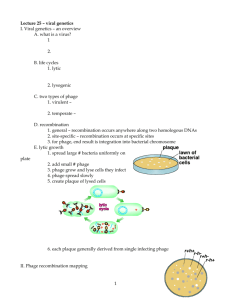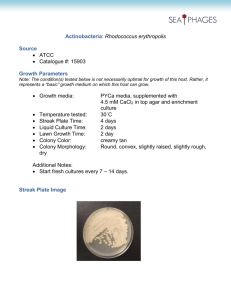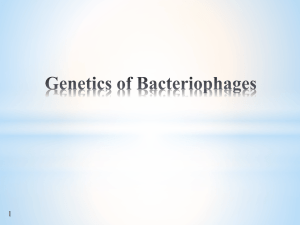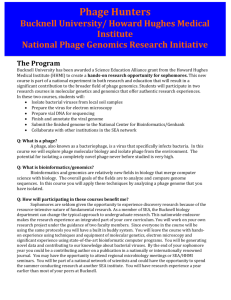ele12465-sup-0001-SI
advertisement
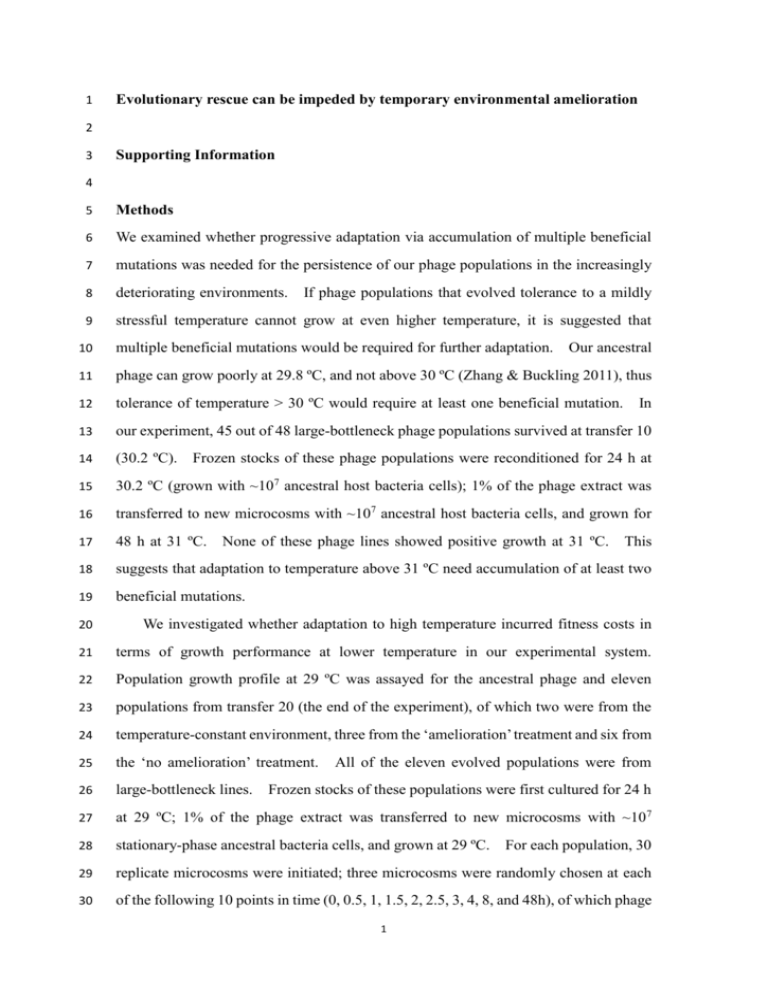
1 Evolutionary rescue can be impeded by temporary environmental amelioration 2 3 Supporting Information 4 5 Methods 6 We examined whether progressive adaptation via accumulation of multiple beneficial 7 mutations was needed for the persistence of our phage populations in the increasingly 8 deteriorating environments. 9 stressful temperature cannot grow at even higher temperature, it is suggested that If phage populations that evolved tolerance to a mildly 10 multiple beneficial mutations would be required for further adaptation. Our ancestral 11 phage can grow poorly at 29.8 ºC, and not above 30 ºC (Zhang & Buckling 2011), thus 12 tolerance of temperature > 30 ºC would require at least one beneficial mutation. 13 our experiment, 45 out of 48 large-bottleneck phage populations survived at transfer 10 14 (30.2 ºC). Frozen stocks of these phage populations were reconditioned for 24 h at 15 30.2 ºC (grown with ~107 ancestral host bacteria cells); 1% of the phage extract was 16 transferred to new microcosms with ~107 ancestral host bacteria cells, and grown for 17 48 h at 31 ºC. None of these phage lines showed positive growth at 31 ºC. 18 suggests that adaptation to temperature above 31 ºC need accumulation of at least two 19 beneficial mutations. In This 20 We investigated whether adaptation to high temperature incurred fitness costs in 21 terms of growth performance at lower temperature in our experimental system. 22 Population growth profile at 29 ºC was assayed for the ancestral phage and eleven 23 populations from transfer 20 (the end of the experiment), of which two were from the 24 temperature-constant environment, three from the ‘amelioration’ treatment and six from 25 the ‘no amelioration’ treatment. 26 large-bottleneck lines. 27 at 29 ºC; 1% of the phage extract was transferred to new microcosms with ~10 7 28 stationary-phase ancestral bacteria cells, and grown at 29 ºC. For each population, 30 29 replicate microcosms were initiated; three microcosms were randomly chosen at each 30 of the following 10 points in time (0, 0.5, 1, 1.5, 2, 2.5, 3, 4, 8, and 48h), of which phage All of the eleven evolved populations were from Frozen stocks of these populations were first cultured for 24 h 1 31 densities were measured. Mean density of the three replicates were used for assessing 32 the population growth profiles. 33 three-phase linear model for microbial growth (Buchanan et al. 1997; Novak et al. 34 2006). 35 population density, log phase with exponentially increasing density, and stationary 36 phase with constant density. Three parameters were obtained from this model: the 37 length of lag phase, the maximum growth rate, and final yield. 38 the model was very high: in all cases, the coefficient of determination was > 0.99. 39 Note that this was an assay of population-level growth performance, but not an assay 40 of ‘one-step’ growth curve. We examined phage populations, rather than individual 41 phage isolates. 42 population. 43 cells (consistent with our selection experiment), which may contain both active and less 44 active cells and thus cause further asynchrony in growth within each phage population. The log-transformed measurements were used to fit a The model assumes three distinct growth phases: lag phase with constant The goodness of fit of There may be heterogeneity in growth performance within each Stationery-phase, but not exponential-phase, bacteria were used as host 45 46 2 47 Figure S1 A graphical illustration of the hypothesis that temporary environmental 48 amelioration during deterioration can slow the fixation of beneficial mutations. 49 asexual populations, as assumed here, favourable mutations need be established 50 sequentially and thus later steps of adaptation are contingent on the success of earlier 51 ones. 52 beneficial mutations may amplify through time. 53 scenario of relaxed, but not reversed, selection for beneficial mutations during the 54 amelioration phases. In Therefore the negative effect of environmental amelioration on the fixation of 55 56 3 Note that panel (d) assumes a 57 Figure S2 Population density of phage lines that evolved in the temperature-constant 58 environment (29 °C). 59 environment; and within each incubator, twelve populations (six with large bottleneck 60 population size and six with small bottleneck population size) were maintained. 61 Different symbols indicate phage lines from different individual incubators. Two replicate incubators were used for this evolution 62 63 64 4 65 Figure S3 Growth profile at 29 ºC of the ancestral and eleven evolved populations, 66 either from the temperature-constant (control) or deteriorating environments. 67 line indicates an individual phage population. 68 69 5 Each 70 Figure S4 Phage population growth characteristics, length of lag phase (a), maximum 71 growth rate (b), and final yield (c), of the ancestral phage and eleven evolved phage 72 lines. 73 environments and those from the temperature-constant (control) environment in the 74 growth characteristics (Mann-Whitney U-test, P > 0.1). This suggests tolerance to 75 high temperature does not incur a cost in terms of growth performance at low 76 temperature, and thus in our evolutionary rescue experiment selection for beneficial 77 mutations was relaxed but not reversed during the amelioration periods. 78 absence of such fitness costs in the finally rescued populations of the ‘amelioration’ 79 environment may result from either (i) that the high temperature-tolerant mutations did 80 not suffer a fitness costs, or (ii) that mutations with fitness costs existed but populations 81 with such mutations went extinct due to the antagonistic selection arising from the 82 environmental fluctuation. 83 amelioration’ evolution lines. There is no difference between the rescued lines from the deteriorating Note that the But only the first explanation is relevant to the ‘no 84 85 86 87 6 88 REFERENCES 89 90 1. 91 Buchanan R.L., Whiting R.C. & Damert W.C. (1997). When is simple good enough: a 92 comparison of the Gompertz, Baranyi, and three-phase linear models for fitting 93 bacterial growth curves. Food Microbiol., 14, 313-326. 94 2. 95 Novak M., Pfeiffer T., Lenski R.E., Sauer U. & Bonhoeffer S. (2006). Experimental 96 tests for an evolutionary trade-off between growth rate and tield in E. coli. Am. 97 Nat., 168, 242-251. 98 3. 99 Zhang Q.-G. & Buckling A. (2011). Antagonistic coevolution limits population 100 persistence of a virus in a thermally deteriorating environment. Ecol. Lett., 14, 101 282-288. 102 103 7


